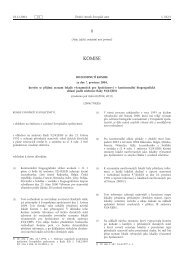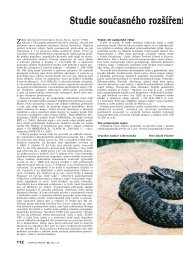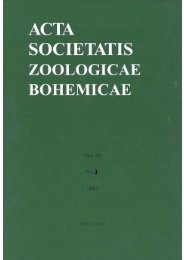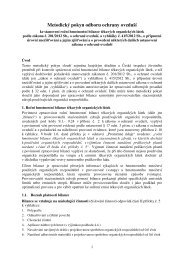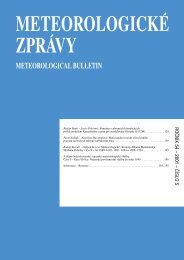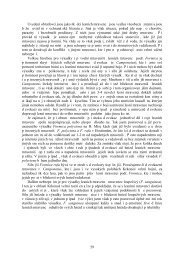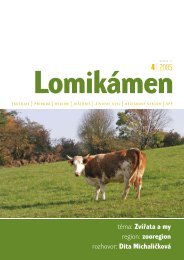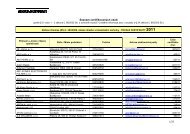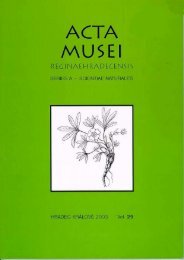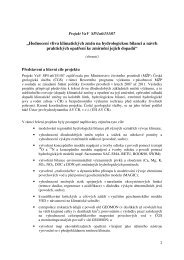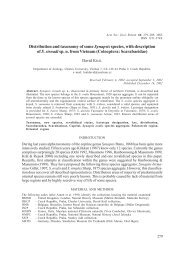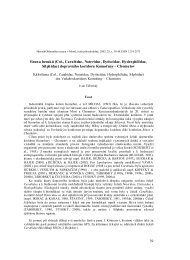journal of forest science
journal of forest science
journal of forest science
Create successful ePaper yourself
Turn your PDF publications into a flip-book with our unique Google optimized e-Paper software.
i i i<br />
i<br />
y = c0 + c1 + ... + cnxn l<br />
l<br />
i i<br />
i<br />
y = w y w<br />
⎛<br />
plying an interpolation method for the creation <strong>of</strong> hydrologically<br />
correct DEM. This method is integrated in the<br />
GRID module called Topogrid (see ESRI 1994).<br />
In the process <strong>of</strong> skyline yarding distance calculation<br />
we used the LATTICE (ESRI 1994) data structure together<br />
with GRID structure for performing the complicated<br />
operations <strong>of</strong> line-<strong>of</strong>-sight analysis.<br />
REUTEBUCH (1988) sees the main problem <strong>of</strong> the<br />
route-projection routines as being conceptual. Routines<br />
rely on an algorithm rather than on the user’s visual abilities<br />
and experience to guide the direction <strong>of</strong> the route.<br />
Applying a fuzzy reasoning mechanism which selects<br />
passing points shows that the direction <strong>of</strong> the route can<br />
be fully controlled in the algorithm.<br />
The fuzzy rule based system which automatically lays<br />
out hauling roads is based on the fuzzy reasoning inference<br />
mechanism which uses the architecture proposed in<br />
TAKAGI et al. (1985, 1986, 1988 in TANAKA 1996).<br />
Their fuzzy reasoning mechanism is classified as the direct<br />
method and was devised using linear functions for<br />
the relevant rules. uzzy reasoning method using linear<br />
functions is based on the following architecture:<br />
Rule i I x is A 1<br />
⎞<br />
⎜∑<br />
⎟ ∑<br />
⎝ ⎠<br />
i1 and ... and x is A n in THEN<br />
i = 1, 2, ...., r<br />
where: i – the superscript <strong>of</strong> rule,<br />
r – the total number <strong>of</strong> rules,<br />
A (k = 1, 2, ... ,n) – fuzzy sets,<br />
ik<br />
x – an input variable,<br />
k<br />
yi – the output from the i-th rule,<br />
c – the parameter <strong>of</strong> the consequence in the i-th rule.<br />
ik<br />
The fuzzy reasoning value is obtained from the weighted<br />
mean:<br />
µ Akx i<br />
( k )<br />
i=<br />
1 i=<br />
1<br />
where: w i – the adaptability <strong>of</strong> the premise <strong>of</strong> the i-th rule<br />
and given by the equation:<br />
w i<br />
n<br />
Akx k<br />
i = ∏ µ ( k )<br />
= 1<br />
where: µ – the membership value <strong>of</strong> the fuzzy<br />
set A . ik<br />
The reasoning rules which are used in our system were<br />
constructed in YOSHIMURA (1997). We changed only the<br />
premise and consequence part <strong>of</strong> the rules to adjust them<br />
for the hauling road projecting conditions valid in Slovakia.<br />
The fuzzy rule based system was programmed according<br />
to the theoretical foundations described in ULLÉR<br />
(1995).<br />
The gradeline projection routine which connects two<br />
passing points is based on a concept <strong>of</strong> path distance<br />
model (GAO et al. 1996). The path distance model attempts<br />
to control the grade between two adjacent cells<br />
using a gradient factor. The gradient factor is a directional<br />
one and it considers the effect <strong>of</strong> the value gradient<br />
from a cell to its neighbour for the cost <strong>of</strong> travel between<br />
two neighbouring cells. Other factors, such as rockiness,<br />
environmental barriers, slope stability information, can<br />
also be controlled by a path distance model. This control<br />
is carried out by applying an isotropic cost surface which<br />
expresses the costs <strong>of</strong> movement in terms <strong>of</strong> distance<br />
equivalents.<br />
CARTOGRAPHIC MODEL O SKYLINE<br />
YARDING DISTANCES<br />
The cartographic model <strong>of</strong> skyline yarding distances<br />
can be regarded as a map <strong>of</strong> distances measured from<br />
every cell as a length <strong>of</strong> the line <strong>of</strong> sight over the terrain<br />
to the nearest road cell (distance between the centre <strong>of</strong><br />
the processed cell and the centre <strong>of</strong> the nearest road cell)<br />
(TUÈEK, PACOLA 1999). The cartographic model is the<br />
result <strong>of</strong> data processing methods used on the collection<br />
<strong>of</strong> maps. Each layer conveys the following information:<br />
digital elevation model – aspect grid – cost allocation<br />
grid (defines for each cell the zone that achieves the minimum<br />
distance in order to reach the cell) – line <strong>of</strong> sight<br />
(evaluation <strong>of</strong> intervisibility) – slope distance <strong>of</strong> line <strong>of</strong><br />
sight as a result (ig. 1). Intervisibility between the processed<br />
cells and the deviation <strong>of</strong> the line <strong>of</strong> sight from<br />
(A) DEM (cell resolution 50 m); (B) Aspect grid; (C) Cost allocation<br />
grid (controls the homogeneity under the line <strong>of</strong> sight);<br />
(D) Intervisibility evaluation; (E) Slope distance <strong>of</strong> line <strong>of</strong> sight.<br />
Note: NODATA – keyword indicating that the cell is not visible<br />
from the point <strong>of</strong> observation<br />
Fig. 1. Cartographic model <strong>of</strong> skyline yarding distances<br />
308 J. FOR. SCI., 47, 2001 (7): 307–313



